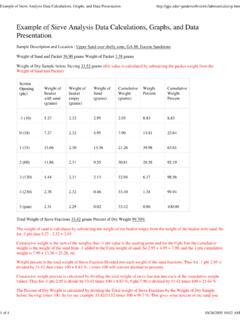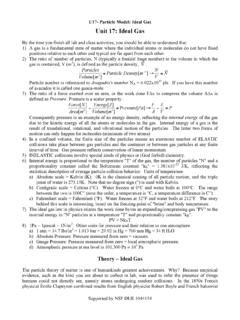Transcription of Sand Grain Size Analysis - Faculty
1 sand Grain Size AnalysisMaterials NeededEquipment:(per table) sets of sieves = 10, 18, 35, 60, 120, 230, pan (6 sieves and the pan) Balances to measure mass of or stereo with a spreadsheet sand sheets of paper(butcher paper or flip chart) sheet of paper- notebook paper will containers to place sieved samples in; these can be weighing trays or beakersIntroductionWhile sediments may seemremoved from biology, they are in fact important. Sedimentsstructure benthic communities because of Grain size preference by various , Grain size makes a difference in the ability of flatfish to bury themselves in mayhavebiologicalorigins in the skeletal material ofcorals,macroalgae, phytoplankton, foraminifera, radiolarians, mollusks, etc. Suspendedsediments have been shown to cause stress and gill damage in fish, smother coral reefs,and decrease benthic primary from the biology, sediment characteristics can provide information about sourcematerials, the depositional environment (how much energy there is in waves andcurrents), and other physical and chemical rocks are broken down into fragments, either through the mechanical means ofweathering, or through chemical reactions, the fragments are called sediment.
2 When thatsediment is compacted or cemented together, it forms a sedimentary rock. Sediments areeither clastic or chemical. That is, rocks are broken down through either mechanical orchemical sedimentClastic sediment is what one usually thinks of when speaking of sediment. From theGreek word klastos (broken), it refers to the broken remains of rocks of all types, brokenand altered by weathering processes such as wind, water and ice. Clastic sediment is alsoknown as detrital sedimentChemical sedimentary rocks may contain fossils and other sedimentary characteristics,buttheir components were not broken up mechanically. Rather, rocks were dissolved insolution (as salt can dissolve in water) and transported, then precipitated chemically (assalt can precipitate out of a saturated solution).This lab willinvestigateunconsolidated sediments. You will learn how to characterizethe particles or grains that are present, the size and size distribution of those grains, andthen make some interpretations from these observations.
3 In addition you will learn somefundamentals of statistics . During the lab you will measure Grain size in two differentways: a) using a settling tube and b) using to properties of a sediment such as particle size, shape, roundness, andsorting. A well sorted sediment is one in which the grains are all about the same size. Incontrast, a poorly sorted sediment contains a chaotic mixture and large, intermediate andsmall grains. Shape is a measure of the sphericity of a Grain . Some grains are almostspherical, whereas others may beelongate or flattened. Particle roundness refers to thesmoothness of a Grain , regardless of its shape. Grains may be rounded ( , no sharpcorners), subangular or angular. The concepts of roundness, shape, and sortingareillustrated in Figures 1 is often a function of distance transported since the corners weardown from abrasion with other is independent of roundedness, and measures how close a graincomes to being spherical or is a measure of how even the particle size distribution.
4 Sample A ispoorly sorted while sample B is the negative log base 2 of the diameter in in the "Rapid Method"lab has conversions from mm or micometers to phi are several documents to the lab. I will bring copies of them so you don't have toprint them out, but they are here for you to look TypesCoastal sediment is made up of weathered terrigenous rock (terrigenous detritus) for themost part, plus organic detritus, plants, worms, sea shells if marine, and pore may also be small amounts of calcite cement. The type of terrigeneous detritus(lets call it TD to keep it simple) found in sediment is dependent upon the types of rocksin the source area of the sediment. If the sediment is down stream from weatheringgranite then certainly expect to see detrital quartz grains in the sediment. If on the otherhand your sediment is sunning itself on the beaches of Hawaiido not expect to see anyquartz, (why not?). Most students when they think of sand or sediment they immediatelythink quartz grains.
5 This is a good guess but not a sure bet. Quartz grains in most casesare the dominant Grain type in a sediment but there will also be rock fragments. These arechunks of rock and yes technically a detrital quartz Grain is a chunk of rock but fordescriptive purposes we keep it separate. Sometimes we can recognize what type of rockthose rock fragments are from. We can expect to encounter sedimentary rock fragments(SRF), metamorphic rock fragments (MRF), and igneous rock fragments (IRF). Grain SizeOne way to characterize a sediment is to determine the sizes of grains in that one could measure all the grains on aparticular beach, for example. Rather thanmeasure each Grain , scientists rely on subsampling. In order to characterize the sediment,one would take a representative sample of the sediment and run it through a set of sievesto break the sample subset in to size classes and using statistics reconstruct what thepopulation's size characteristic are (much easier and quicker).
6 statistics are a way todescribe populations of things, like fish or trees, and Grain from the American Geological Institute Glossary, 6th ed., 1980 mean:an arithmetic average of a series of values. median:the value of the middle item in a set of data arranged in rank order. If theset of data has an even number of items, the median is the arithmetic mean of themiddle two ranked items. mode:the value or group of values that occurs with the greatest frequency in a setof data; the most typical observations. standard deviation:the square root of the average of the squares of deviationsabout the mean of a set of data. skewness:the quality, state, or condition of being distorted or lacking symmetry. kurtosis:the quality, state, of condition of peakedness or flatness of the graphicrepresentation of a statistical :The phi value is thenegative logarithm to the base 2of the particle phi size you can use theExcel function"-log(number, base)". Where number isthe diameter in mm, and base is the result to 1 decimal Analysis Laboratory Procedure(1) Take approximately a 100 gram split of a sample.
7 Examine it briefly with ahand lensor microscope and make appropriate notes about its this into Table1and includewhat you perceive thesize of the average grainto be ( sand boxsand in aplaygroundis medium grained, iflargersized grains dominate thenit is coarsegrained,and if smaller then fine grained).How well sortedis the sample (all or mostgrains are the same size then well sorted, some range in Grain size then sorted, and ifthere is quite a bit of variation in Grain size then poorly sorted). Are the grains for themost part angular, sub-angular to sub-rounded, rounded, or well rounded? What is thesphericity of the grains; compact or spherical, bladed, elongate? What types of grainsarepresent; quartz, feldspar, rock fragments, mica, shell material? Test a small amountof each sample with a drop or two of dilute hydrochloric acid (HCl). If it fizzes thereis carbonate material (shell, coral, etc.) pick through the sample andremove all large chunks of vegetation and bugs.
8 (2)Weigh the sampleon the balance and record the mass of the samplein Table 2.(3) Take a set ofsievesand make sure that theyare stackedsuch that the screen with thesmallest opening is at the base and the largest is at the top. Note that the screenshave different numbers on them. These are referring to different types of size most common are the US Standard Sieve Mesh #, opening in millimeters(micrometers), opening in inches, and Phi Scale; see table below. Place the pan at thevery base of the stack. Dump your sample onto the top screen and put the cover on thetop screen.(4) With acircular motion shake thesievesand occasionally rap gently iton the benchtop. Do thisfor5 minutes, no more and no less.(5) Gently pry off the top cover of the screen set. You may need to use a dime to aid inthis. In the same manor remove the first screen from the stack; being very careful notto launch any grains off across the lab (don't forceit be gentle). Lay a clean sheet ofpaper that is larger than the area of the screen on the bench the screen overand dump its contents on the paper.
9 Transfer the sand on the paper to the weighingpaper or pan. Then take the screen and turn it over and rap its rim once on the surfaceof the the grains to the weighing pan. Rap it again but a little harderthis time and then dump the grains. Then slam the sieve down on the paper such thatthe entire rim contacts the paper at once; dump the grains onto the weighing pan andset the screen NOT ATTEMPT TO POKE LOOSE THE GRAINSTHAT REMAIN ON THE SIEVE; NEVER TOUCH THE WIRES OF THESIEVE WITH will probably leave behind some grains, big deal,you also will probablygain a few grains from the previous user of the screen. Thiscontributes to measurement error and everyone understands that.(6)Weigh out what you have dumped from the sieve and recordthe results on a sieveanalysis form. Set aside the sample split (what you just weighed) for futureobservations. See the end of this for an example of how one might set up a data sheetfor doing this.(7) Repeat (5) and (6) for each screen and the pan.
10 (8)Add up all the weightsfrom each screen and the pan. Does it compare to you initialsample weight? Take the difference between the two and divide by the total weight ofthe size fractions. This is you measurement error. What are the sources of this error?(9)Construct a histogramof your results. I know that you all know how to make ahistogram, but I want you to think about what you are doing before you construct columns of the histogram will have a width proportional to the size range ofgrains (expressedusing the phi scale) for each sample split. For example if you useda -1, -2, and-3 phi screens then the sample which was on the-2 screen represents allthe grains which were greater in diameter than-2 but less in diameter than-3. Yourhistogram must reflect this and if you were using odd steps in sievesize then thewidths of the various columns will vary. The height of the column will be proportionalto thepercent retainedon the respective screen and therefore it will be in units ofpercent, not units of mass or tallest column indicates themodeof the Grain size distribution.

